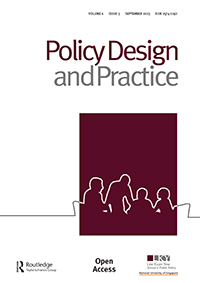Tapping into community expertise: stakeholder engagement in the design process
IF 2.6
Q1 PUBLIC ADMINISTRATION
引用次数: 1
Abstract
Abstract The Connection to Care (C2C) project, a transdisciplinary work-in-progress, employs community-engaged participatory research and design methods at the nexus of policy adaptation and product innovations. C2C aims to advance practices that identify and leverage the critical junctures at which people with substance use disorder (SUD) seek lifesaving services and treatment, utilizing stakeholder input in all stages of design and development. Beginning in the Fall of 2018, members of our research team engaged with those at the forefront of the addiction crisis, including first responders, harm reduction and peer specialists, treatment providers, and individuals in recovery and in active substance use in a community greatly impacted by SUD. Through this engagement, the concept for programs and products representing a connection to care emerged, including the design of a backpack to meet the needs of individuals with SUD and those experiencing homelessness. From 2020 to 2022, more than 1,200 backpacks with lifesaving and self-care supplies have been distributed in local communities, as one component of the overall C2C initiative. The backpack is a recognized symbol of the program and has served as an impetus for further program and policy explorations, including as a lens to better understand the role of ongoing stigma. Though addiction science has evolved significantly in the wake of the opioid epidemic, artifacts of policies and practices that criminalize and stigmatize SUD remain as key challenges. This paper explains the steps that C2C has taken to address these challenges, and to empower a community that cares.利用社区专业知识:利益相关者参与设计过程
摘要“与护理的联系”(C2C)项目是一项正在进行的跨学科工作,在政策适应和产品创新之间采用了社区参与的研究和设计方法。C2C旨在推进识别和利用物质使用障碍(SUD)患者寻求救生服务和治疗的关键时刻的实践,在设计和开发的所有阶段利用利益相关者的投入。从2018年秋季开始,我们的研究团队成员与处于成瘾危机最前线的人进行了接触,包括急救人员、减少伤害和同行专家、治疗提供者,以及在受SUD严重影响的社区中正在康复和使用活性物质的个人。通过这种参与,代表与护理联系的项目和产品的概念出现了,包括背包的设计,以满足SUD患者和无家可归者的需求。从2020年到2022年,作为C2C整体计划的一个组成部分,在当地社区分发了1200多个装有救生和自我护理用品的背包。背包是该计划的公认象征,并推动了进一步的计划和政策探索,包括作为一个镜头,更好地理解持续污名化的作用。尽管成瘾科学在阿片类药物流行后发生了重大变化,但将SUD定为犯罪和污名化的政策和做法仍然是关键挑战。本文解释了C2C为应对这些挑战并赋予关心社区权力而采取的步骤。
本文章由计算机程序翻译,如有差异,请以英文原文为准。
求助全文
约1分钟内获得全文
求助全文
来源期刊

Policy Design and Practice
PUBLIC ADMINISTRATION-
CiteScore
10.30
自引率
4.30%
发文量
19
审稿时长
13 weeks
期刊介绍:
 求助内容:
求助内容: 应助结果提醒方式:
应助结果提醒方式:


